Accepted Scientific Name: Consolea moniliformis (L.) A.Berger
Entwicklungslin. Kakt. 94 (1926). A.Berger
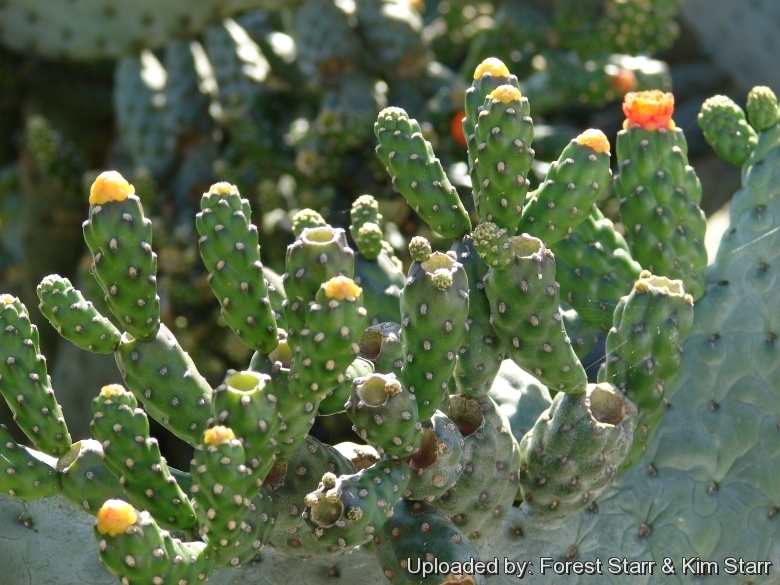
Cactus moniliformis (Consolea moniliformis) Photo by: Forest Starr & Kim Starr
Flowers at Paia, Maui, Hawaii (USA). April 29, 2009.
Origin and Habitat: Consolea moniliformisSN|9726]]SN|9726]] occurs in Cuba, Dominican Republic, Haiti and in Puerto Rico on Mona Island, Culebra and Desecheo.
Altitude range: It occurs at elevations from sea level to about 50 metres.
Habitat and Ecology: In Cuba, it occurs in dry littoral forest. It also occurs on limestone. In Puerto Rico, it occurs in open dry forests and is sparsely distributed. In Santiago de Cuba it is cultivated in gardens. It is abundant where it occurs. Its population is male-biased throughout the range. It is unknown whether there is seedling recruitment in the wild.
Synonyms:
See all synonyms of Consolea moniliformis
Common Names include:
ENGLISH: Necklacelike pricklypear
FRENCH (Français): Opuntia patte-de-tortue, Patte de tortue, Patte tortue, Raquette espagnole (Haiti)
HAITIAN CREOLE (Kreyòl ayisyen): Pat tôti, Rakèt panyôl
SPANISH (Español): Alpargata (Dominican Republic), Tuna (Puerto Rico)
Description: Consolea moniliformisSN|9726]]SN|9726]] (a.k.a. Opuntia moniliformisSN|9727]]SN|9727]]) is a tree-like cactus species to 4(-7) m hight, freely branching in the crowns. In this species, as in a few other opuntias, the fruits are quite proliferous, often in long chains of 2-5 (or more) individuals or forming compound clusters. They hangs on for a number of years and usually remaining green. They are, however, easily detached, and on falling to the ground, readily take root and start new colonies.
Stem: The trunk erect, well defined, somewhat flattened above, unjointed, 3-4 m tall branching at the top and densely armed with spines; the branches widely spreading; joints flat, obliquely linear-oblong, sickle shaped or obovate, 10-30 cm long, 7-13 cm broad, about 1 cm thick, obtuse, distinctly areolate-reticulate.
Areoles: Somewhat elevated, 1 to 1.5 cm apart, with brown glochids
Spines: Yellowish or grey, acicular and sharp sometimes absent. The spines in the trunk are numerose sometimes to 12 cm long (usually much shorter) , their bases clothed with yellowish-white wool 1 to 2 cm long; those of young joints 3 to 6 near the edges of the areoles, 1 to 2.5 cm long; those on the sides of the young joints often spineless or with 1 to 3 yellowish spines, and with small tufts of greyish wool; older joints bearing at all areoles 5 to 8 yellowish spines similar to those of the trunk, and brown glochids 6 or 8 mm long. Some of the joints and, perhaps, some whole plants of this species are nearly or quite spineless.
Flowers: Yellow to orange to 5 cm long and 2.5 cm in diameter, opening widely, with recurved perianth parts; sepals as broad as long, or broader, apiculate; petals yellow to orange, ovate, apiculate, spreading; stamens much shorter than the petals; pericarpel cylindric to obovoid-cylindric, terete or nearly so, 4 to 5 cm long, its distinctly elevated areoles close together, only 5 or 6 mm apart, bearing brown glochids 2 mm long, but no spines.
Fruit: Oblong-obovoid to ovoid, up to 6 cm long.
Subspecies, varieties, forms and cultivars of plants belonging to the Consolea moniliformis group
Bibliography: Major references and further lectures
1) Forest & Kim Starr. Plants of Hawaii. <http://www.starrenvironmental.com>. Downloaded on 20 August 2014.
2) M.M. Grandtner “Elsevier's Dictionary of Trees” Volume 1: North America, Volume 1 Elsevier, 08/Apr/2005
3) Alain H. Liogier “Descriptive Flora of Puerto Rico and Adjacent Islands: Spermatophyta. Cyrillaceae to Myrtaceae” La Editorial, UPR, 01/Jan/1994
4) Negrón-Ortiz, V., Griffith, P., Taylor, N.P., González Torres, L.R. & Barrios, D. 2013. Consolea moniliformis. The IUCN Red List of Threatened Species. Version 2014.2. <www.iucnredlist.org>. Downloaded on 24 September 2014.
5) Edward Anderson “The Cactus family” Timber Press, Incorporated, 2001
6) James Cullen, Sabina G. Knees, H. Suzanne Cubey "The European Garden Flora Flowering Plants: A Manual for the Identification of Plants Cultivated in Europe, Both Out-of-Doors and Under Glass" Cambridge University Press, 11/Aug/2011
7) David R Hunt; Nigel P Taylor; Graham Charles; International Cactaceae Systematics Group. "The New Cactus Lexicon" dh books, 2006
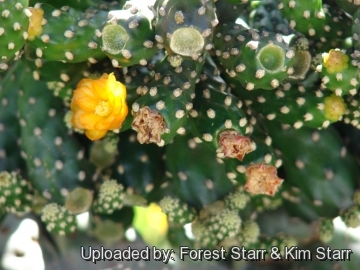 Flowers at Paia, Maui, Hawaii (USA). April 29, 2009. (Consolea moniliformis) Photo by: Forest Starr & Kim Starr
Flowers at Paia, Maui, Hawaii (USA). April 29, 2009. (Consolea moniliformis) Photo by: Forest Starr & Kim Starr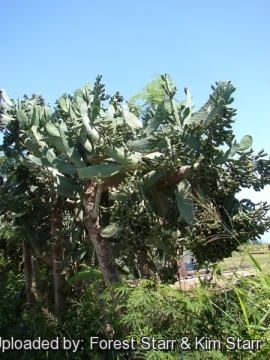 Flowering habit at Paia, Maui, Hawaii (USA). April 29, 2009. (Consolea moniliformis) Photo by: Forest Starr & Kim Starr
Flowering habit at Paia, Maui, Hawaii (USA). April 29, 2009. (Consolea moniliformis) Photo by: Forest Starr & Kim Starr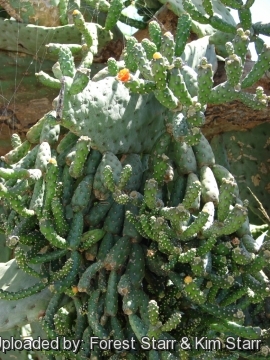 Flowers at Paia, Maui, Hawaii (USA). April 29, 2009. (Consolea moniliformis) Photo by: Forest Starr & Kim Starr
Flowers at Paia, Maui, Hawaii (USA). April 29, 2009. (Consolea moniliformis) Photo by: Forest Starr & Kim Starr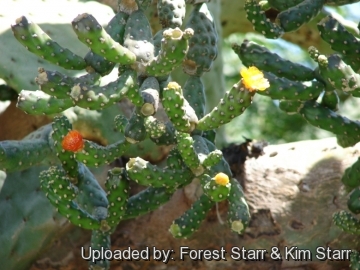 Flowers at Paia, Maui, Hawaii (USA). April 29, 2009. (Consolea moniliformis) Photo by: Forest Starr & Kim Starr
Flowers at Paia, Maui, Hawaii (USA). April 29, 2009. (Consolea moniliformis) Photo by: Forest Starr & Kim Starr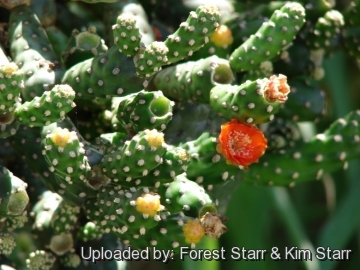 Flowers at Paia, Maui, Hawaii (USA). April 29, 2009. (Consolea moniliformis) Photo by: Forest Starr & Kim Starr
Flowers at Paia, Maui, Hawaii (USA). April 29, 2009. (Consolea moniliformis) Photo by: Forest Starr & Kim StarrSend a photo of this plant.The gallery now contains thousands of pictures, however it is possible to do even more. We are, of course, seeking photos of species not yet shown in the gallery but not only that, we are also looking for better pictures than those already present.
Read More... Cultivation and Propagation: Consolea moniliformisSN|9726]]SN|9726]] is a much decorative tree-like cactus seldom found in cultivation. It is a tropical summer grower species that offers no cultivation difficulties. This cactus can be grown as a shrub or tree, and may look attractive as it. Its green joints and yellow-orange flowers provide a striking accent for an otherwise dormant cactus garden.
Soil: It will grow in any kind of drained soil, and will resist to droughts, but prefer regular waterings. In pot culture use a draining substratum, as it is sensitive to rottenness when in presence of humidity and low temperatures and let the soil dry out between waterings.
Repotting: Repot in the spring, when their roots become cramped. Generally, they should be repotted every other year in order to provide fresh soil. After repotting, do not water for a week or more.
Water: In summer, during the vegetative period, it must be regularly watered, but allowing the substratum to completely dry up before irrigating again (but do not overwater ); in winter, it’s to be kept dry. Preferable not to water on overcast days, humid days or cold winter days.
Hardiness: It is not a frost resistant cactus, hardy to -2° C or less if very dry. However in cultivation it is better not to expose it to temperatures lower than -5° C, even if in an aerated and protected location, in order to avoid the formation of anti-aesthetic spots on the epidermis. In presence of high atmospheric humidity avoid any frost as it is particularly sensitive to root rot. It can handle extremely high temperatures in summer.
Exposure: Outside full sun or afternoon shade (but adapt to shade too), inside needs bright light, and some direct sun.
Use: It is suitable for “desert” gardens, in association with other xerophytes. Where the open air cultivation is not possible due to the climate, it is to be cultivated in pot in order to shelter it in winter.
Warning: Some clones are armed with treacherous spines that are extremely sharp. Handle it with extreme caution, and keep it away from gangways and areas frequented by children and animals. Spines must be meticulously removed with tweezers.
Propagation: Can be propagated by cuttings. Prickly pear pads root easily and grow rapidly when placed in loose, well-draining soil.
















